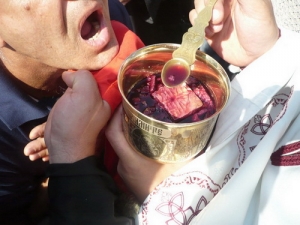

Father George Bithos' weblog

Behold, I stand at the door and knock;
if anyone hears my voice and opens
the door, I will come to him and eat with
him, and he with me.
Isn’t this quite an invitation? Christ is waiting for us. His response to our faith is assured. So like a child whose first steps are tentative, our first faith steps may be shaky. God is there waiting for us no matter how weak our faith. He has promised us that if we reach out, as did St. Peter, he will grab us by the hand. The invitation from Christ is offered more often than we realise. At each Divine Liturgy we are issued an invitation. The call to the Chalice allows us to reaffirm our Baptism. It is our adult response to eat with Christ and to partake of him. Our God stands in waiting. No matter how far we have wandered or how long it has been. The invitation is prepared and personal. Our faith is not an exercise by which we test God, but rather an opportunity to engage God in our life. Faith depends on our attitude. Do we realise that we have move away from God? Is there faith, however weak? More importantly, do we love God? Our invitation awaits us. The invitation reads:With the fear of God, with Faith and Love
Draw near!
]]>
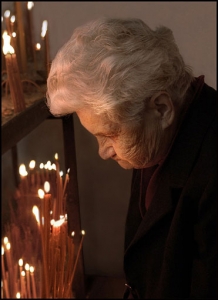
Now faith is the substance of things hoped for, the evidence
of things not seen. (Hebrews 11, 1)
One of the strengths of the Church is that each of us learn from the other. Last week, I said we are all responsible for teaching children. The beauty is that we can learn from everyone in the Church. If we stop and try to quietly follow the examples of faith around us; it will help our own spiritual growth. Бабушка can teach all of us. Grandma’s faith is born from years of prayer. Sittie’s trust in God gives us all an example, which will guide us. Last Saturday, we celebrated the Dormition of the Theotokos, the Panagia is the model of the Church; remember her words: “Behold I am the handmaiden of the Lord; let it be according to your word.” ( Luke, 1, 38) Trust in God, by putting things in His hands. YiaYia has learned her simple faith; and she shows us this in her unbounded love. As we approach faith, we must learn both from YiaYia and from our children. They share a simple trust in God. Yiayia’s trust is born from prayer, and a child’s trust is born from innocence. They are two examples from different ages, but are they really that dissimilar? Putting faith in God give both, YiaYia and a child, a serene confidence and a peaceful reliance on His Love. Knowing that God loves us no matter who we are should allow us to put our hearts at ease. We have children, YiaYia and what is more important the example of the Most Holy Theotokos to guide us. Let us declare, as did the father of the epileptic boy: “I believe; help my disbelief!” (Mark 9, 24).]]>

APOLYTIKION
In giving birth, you did preserve your virginity, in your dormition,
you did not forsake the world, O Theotokos. You were translated unto life,
since you are the Mother of Life; and by your intercessions
you do redeem our souls from Death.
KONTAKION
The grave and death could not hold the Theotokos,
who is unsleeping in her intercessions and an unfailing hope
in her mediations. For as the Mother of Life she was translated to life
by Him who dwelt in her ever-virgin womb.
]]>
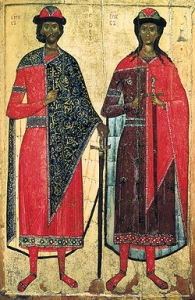
Greetings in the Lord !
I wish to thank my readers in the Orthodox Lands of Russia and all Orthodox Slavic Countries. You are appreciated, loved and I continue to pray for you. I read all your comments, but I must depend on a translating software by Apple to translate them. Regrettably, I do not speak Russian. All comments are screened. I approve those which can be translated. I will spam all improper or lewd comments, but will try my best to translate, read and approve all of them; even the critical ones. I will answer all questions that are proper.
May God strengthen Orthodoxy and your faith journey. Thank you for visiting my site. вы и Бог благословляет!
Dn. George
]]>
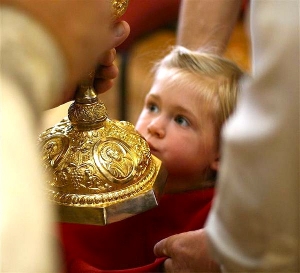
Teach Your Children Well
You who are on the road Must have a code that you can live by And so become yourself Because the past is just a good bye.
I saw this beautiful photograph and immediately thought of this song from my youth by Crosby Stills and Nash. Now that I am a grandfather, the sentiment means so much more to me than it did in the sixties. The lesson you learn as a clergy man who is privileged to offer the Body and Blood of Our Lord to the faithful is that children show if they have been taught well. How children approach the Holy Chalice says worlds about their first Church, the Church of the Home. I have heard many opinions and arguments concerning frequent communion, but none are as powerful as a child approaching the Holy Cup with love and joy. Please, don’t misunderstand me all of us, even children, will have an off day. Perhaps, they’re tired or restless or it’s just one of those days. But, you can always tell a little one who comes to Church often and receives Christ in their life often. They show the love in their hearts with their eyes.
Teach your children well…All of us parents, grandparents and Godparents should teach well. There are many of us who teach, even if we don’t have children. Yes, we are all on a road and for a short time we carry little ones, until they walk on their own. Instilling a code they can live by is our responsibility. The community of faith is all of us; and we all have a duty to pass on this faith. We live in a world that at best ignores faith. Even worse, it can ridicule and denigrate faith. We cannot teach faith only on a Sunday morning. We must live our faith each day and reflect the love of Christ in our hearts with joy. Carefully answer questions of the young putting Christ first. We have all heard the expression, “We teach by example.” The lyric says: “so become yourself,” becoming your genuine self is living in Christ each day. Do this and with God’s help, you will teach your children well!
]]>
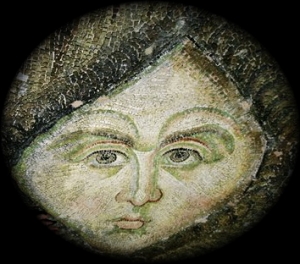
“All creation rejoices in thee, O Thou that art full of grace, both in the hierarchy of the Angels and the generations of men. Thou art a hallowed temple, and a spiritual paradise, the glory of virgins, whence God was made flesh and became a little Child, He Who is from Eternity our God. For He made thy womb His throne, and formed Thy body to be broader than the Heavens. All creation rejoices in Thee, O thou that art full of grace, glory to Thee. “
Now once again, the angelic face is visible. Waiting there to join with the heavenly host to sing praises to the Incarnate One and the Theotokos, who is “more honourable than the Cherubim; and more glorious beyond compare than the Seraphim.” This is a manifestation of the true purpose not only of the angel, but also of the temple. The way the angel was covered suggests that it may be the first to be uncovered and that more may be awaiting under the surface to be revealed. From iconographic schemes, angels are usually not placed singularly, except for the Archangels. Our prayer is that this is the first, of many, we will see. Just as we know that each of us is accompanied by our guardian angel, this uncovered angel has been as a silent guardian to the image of the Platytera and the Incarnate Christ. Axios!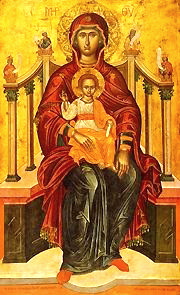
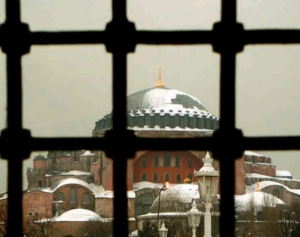
“A Turkish official says restoration workers have uncovered the never-before-seen mosaic face of an angel at Istanbul’s Haghia Sophia – a former Byzantine cathedral.”
This was a headline on the Fox News website. This really disturbed me, as it should all Orthodox Christians. “Never before seen,” what about those countless Christians who worshipped in the Church of the Holy Wisdom from the time of Justinian, until the fall of Constantinople. Don’t they count? This is revisionist history at it finest! The angel was not seen since the Ottomans plastered them over to hide the Truth. So, those Orthodox Christians who prayed in the Cathedral, who placed the mosaic are not to be heard. How sad! Where are the voices telling the world how false these assertions are? Who speaks for the Church in captivity, forced to keep it mouth shut to endure? Where is St. Maximos, St. Mark of Ephesus, the voice of the Church? We are a Church in captivity, a Church muzzled for the sake of political expediency. But, where are the voices in the West? Cannot we speak with a loud voice? The sad thing is the only time we scream with our voices is to criticise the Church and her leaders. The Patriarch did this, the Archbishop didn’t do this, our Metropolitan said the wrong thing. How very sad. Why can’t we speak with a loud voice to decry injustice and to say, this is not a dead Church. It was, is and always will be, at its heart a Church built to the Glory of God. That angel’s image should reminds us of the Seraphim that surrounds the throne God. “Holy, Holy, Holy is the Lord of Hosts; the whole earth is full of Your Glory!”
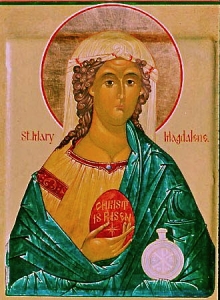
July 22 is the Feast Day of St. Mary Magdalene. I believe that Mary is one of the most interesting of our saints. She is a woman of great theological significance, but she is not well documented in history. The Tradition of the Church, gives us a good bit to think of concerning this special person. She carries several “titles” in the Church usage. She is known most of all as Mary Magdalene. With this, we know she came from a town named Magdala. This city was located on Lake Gennesaret (“a garden of riches”), which is another name for the Sea of Galilee or Lake Tiberias. Geographically the town would be located presently north-west of Haifa, Israel near the Golan Heights. This places her town north of Nazareth. Mary also carries the titles of “Apostle to the Apostles, Equal to the Apostles and of course Myrrh-bearer” There is mistaken idea that Mary was a prostitute before she met Jesus. This is not true! There is a tradition that Mary Magdalene led such a chaste life that the devil thought she might be the one who was to bear Christ into the world, and for that reason he sent seven demons to torment her. The first time Mary is mentioned in the Gospels is St. Luke 8,1-3; Christ freed her from these demons and she followed him thereafter. She is considered one of the Galilean disciples. We see her prominently in the Passion narratives. She followed Jesus to Jerusalem and was steadfast at the foot of the Cross with The Virgin Mary standing by Jesus in His darkest moments. She figured importantly in the post-resurrectional accounts. She is the first person to see the Risen Lord, whom she saw twice, she spoke to Him near the tomb, She was the first to announce the Resurrection. The privilege of being the “first” witness of the resurrection that was granted to Mary by the Lord is something that twentieth century sensibilities need to absorb. In the time of Christ, women were not considered creditable witnesses. They were not allowed to give testimony, only men were considered believable. Yet to Jesus this didn’t matter. He trusted these disciples, these women disciples to deliver the greatest news in the history of the world. She had seen Jesus die on the Cross, seen Him buried, seen the great stone set at the door, seen the guard posted at the door of the tomb, her tears were shed for her teacher, she saw a stranger in the Garden, until she heard a familiar voice call her name. She then saw Him resurrected and glorified. Joy overcame sorrow! As Jesus instructed her, Mary Magdalene found the other disciples. She was a member of the inner circle; she was trusted by them and when she delivered the message, “I have seen the Lord” (John 20,18) they did not believed her. Jesus had to appear to them and upbraid them before, even her friends, would believe such news. The other appearances of Jesus are well documented in the Gospels.
After the Ascension and Pentecost, Mary travelled from Jerusalem to Rome where she announced the resurrection. One tradition concerning Mary Magdalene says that she used her position to gain an invitation to a banquet given by Emperor Tiberius. When she met him, she held a plain egg in her hand and exclaimed “Christ is risen!” Caesar laughed, and said that Christ rising from the dead was as likely as the egg in her hand turning red while she held it. Before he finished speaking, the egg in her hand turned a bright red (for more details, see Wikipedia). Each time we answer, “Truly, He is Risen!” we should think of Mary. After many years evangelising across the Mediterranean area, she travelled to Ephesus where she joined St. John the Evangelist and her friend, the Virgin Mary, the Theotokos. There she died peacefully. During the second Patriarchate of St. Photios the Great, he had her relics transferred to the Queen City (Constantinople).
]]>

In the last few weeks, we have heard from various sources that the secular government in Turkey is planning to allow the historic Holy Theological School of the Ecumenical Patriarchate, located on the island of Halki, to open, again. The Monastery of the Holy Trinity on Halki was founded during Byzantine period. The establishment of the monastery can be traced back to St. Photios the Great, Patriarch of Constantinople, (858–861 and 878–886). The Halki seminary was founded by Patriarch Germanos IV in 1844 at the monastery. It was intended to supply priests for the Ottoman Empire’s Greek minority, it expanded and grew in size and facilities. Set amid cool pines and palm trees, the seminary has the high ceilings, wide halls and well-worn wooden desks of schools built before computers and air conditioning; but this celebrated school has trained generations of scholars, priests and its graduates became bishops and future patriarchs. As a reaction to the Cypriot/Turkish/Greek crisis, the School was closed by the Turkish officials in 1971. For over thirty-five years, this violation of international law has caused great distress and generated calls for the reopening of the School by government, religious, academic and civic leaders across the world. In a past Reuters’ article, this comment was made on the closure: “We have not lost hope, despite the broken promises, because a person only lives as long as he has hope. Even on his deathbed, he resists the end,” His Eminence Metropolitan Apostolos (Daniilidis) of Moschonissia, Halki’s abbot, said from his office atop the “Hill of Hope” on Heybeliada (Halki). Perhaps, the moment we have hoped for has arrived! Hope for the historic step was generated by statements from Turkish officials. “The Halki seminary on the island of Heybeliada is to be reopened,” Culture Minister Ertuğrul Günay said, and adding that they are searching for a formula to integrate the Orthodox theological school into Turkey’s university system. “Although we have not finalized a decision in the Cabinet, my personal impression is that we are going to open the seminary,” said Günay, speaking on Kanal 24 television over [last] the weekend. This was not the first time a statement with the same tenor has been made by Turkish officials in the last few weeks.

The need for Halki is beyond question. Yes, there are good Orthodox Theological schools elsewhere in the world. Students will attend these schools and get a good education to serve their local churches. In my opinion, the need for Halki centres on two loci. One, the Patriarchate needs trained clergy and scholars. These men and women, (yes, I believe Halki should train women theologians) should be prepared and educated, at the very highest level, with an international vision, which focuses on the needs of an international Orthodoxy for the future. In this world of mass media, global communications, and instantaneous change; the Phanar needs to train its own “specialists” in an academic environment that it designs and controls. This prerequisite makes the design of the curriculum critical. Yes, students should receive the treasury (parakatatheki) of Tradition, but this must be transmitted with the tools of the twenty-first century. Additionally, the perspective of the “needs” of the Patriarchate are not the focus of any institution; Halki would provide this frame of reference. The School would also be a fount of post graduate and exchange student training. These students would come to Turkey from all over the world. Furthermore, the requirements of Turkish law make the training of clergy in Turkey imperative. Without this source of clergy and future hierarchy, the Patriarchate is slowly strangled, it withers and dies.
Turkey’s Prime Minister Tayyip Redone needs to be encouraged and thanked for his courageous stance. We pray that this step occurs quickly. The world community would, no doubt, look favourably on a government which corrects the errors of the past and looks to the future.
]]>